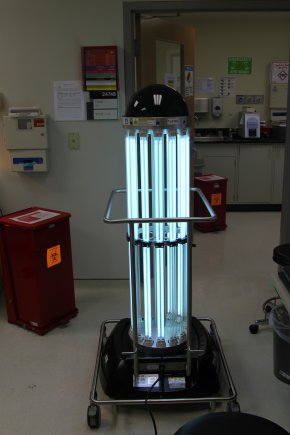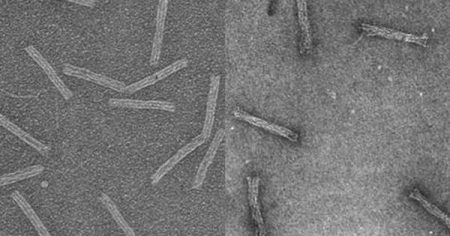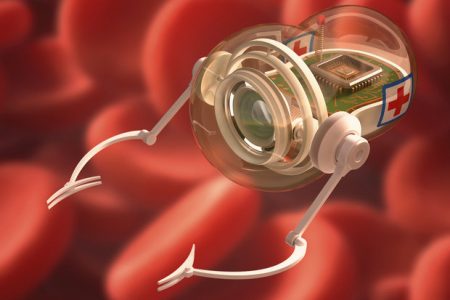July 26, 2017 – Robots are finding their way into medical practice in many ways. Here are two innovations, one already in use to make current procedures safer, and the other presenting a technology that could be revolutionary in guided site treatment of many internal diseases including a range of cancers.
Ultraviolet Light-Casting Robot Disinfects Operating Rooms
Meet TRUDI, a 165-centimeter (65-inch) infection-fighting robot first introduced at a Korean military hospital to disinfect operating rooms after the hospital staff does its normal post-surgical clean-up. TRUDI is an acronym for Total Room Ultraviolet Disinfector.
How does TRUDI work?
The robot is equipped with 28 ultraviolet (UV) lamps that flood the operating room with light penetrating even those areas in shadow. The robot gets placed in the room and administers its UV bath from a single point covering the entire facility. For the most persistent bacteria and viruses, such as clostridium difficile (C-difficile), methicillin-resistant staphylococcus aureus, carbapenem-resistant enterobacteriaceae, and others, it is proving to be an effective killer.
What makes UV light effective in killing bacteria and viruses?
On July 10th I wrote about the surface of Mars and how it is a death trap for Earth bacteria. The main reason, in the case of Mars, is high-energy UV rays continuously bathing the surface of the planet. And what works on Mars also can work on Earth. That’s because UV rays disrupt DNA causing basic cellular functions to fail.
Not all UV light is fatal. That’s because UV comes in three flavours known as A, B, and C. The first two have longer wavelengths and carry less energy. They cannot penetrate the cell membrane. But bacteria exposed to UVc long enough die making it a very effective germicidal agent.
Who else is using TRUDI?
The patented robot technology is being deployed at Walter Reed, the Martin Army Community Hospital in Fort Benning, and the Womack Army Hospital at Fort Bragg. The technology is not considered a replacement for normal surgical post-op clean-up, “but rather an additional step to further sanitize the rooms for patient care,” states Ed Manley of TRUDefense, Inc., the company that created TRUDI.

Nanobot Designed to Deliver Medicine Swims Through the Circulatory System
A Chinese engineering team at the Harbin Institute of Technology, Harbin, China, has designed a nanobot capable of swimming through the bloodstream at 10 micrometers per second. The robot, a mere 5 micrometers long consists of three parts connected by links. The body is gold. The two arms are nickel. An external application of a magnetic field makes the arms propel the nanobot forward.
States Eric Diller, University of Toronto, “it’s small enough basically to go anywhere within the body,” which makes this nanobot an effective tool for targeted delivery of medicine for a wide range of diseases.
The biggest challenge is the size of the robot. Each can only carry a limited medical payload because these little guys are smaller than a grain of sand. For doctors it means injecting many into a patient, and then tracking all of them to ensure they do their job and then are eliminated or extracted.
The current nanobot is not biodegradable which means elimination and extraction present a challenge. You don’t want these little swimmers continuing to move about after they have served their purpose. So the plan is to make future nanobot versions biodegradable.
In the interim, however, the nanobot could be used to treat some diseases where the device would not be introduced into the blood system. For example, urinary tract or retinal diseases could easily use the nanobot as a treatment delivery system.
Team leader at Harbin, Tianlong Li sees the technology mature enough for use in people within 5 years. The next step is to test the technology in animals.









